Dublin has always been an important stopover on the Europe trip of any discerning traveller. After all who would miss a chance of roaming around the streets where James Joyce and Johnathan Swift once wandered? And who could resist the academic glamour of the Trinity College or the lure of the magical Guinness? The literary atmospheric city that’s also a gastronomic hub is scenically bisected by the River Liffey. Just 8 km from the bustling city are the scenic Dublin Mountains… hiking and nature watching paradise.
Attractions and Activities
Many centuries back a smart brewer called Arthur Guinness purchased a 9000-year-old lease on a brewery and some 200 years later Dublin’s one of the top attractions Guinness Storehouse was born. Masterfully created according to the norms of the Chicago school of architecture this was originally a fermentation house. Right now it’s a hub of multimedia exhibitions on all things Guinness and the best place to sip a glass of the black magic. It’s located at the St. James’s Gate Brewery.
Dublin’s beautiful pair of cathedrals St Patricks and Christ Church are lovely enough to steal your breath. St Patrick has 19th century stained glass creations and a serene lady chapel along with a well where the patron saint of Ireland performed initiation rights into Christianity. Incidentally, this is the national church of Ireland. This is also where Johnathan Swift (who served as dean here for 35 years) and his lady love Hester Johnson are buried.
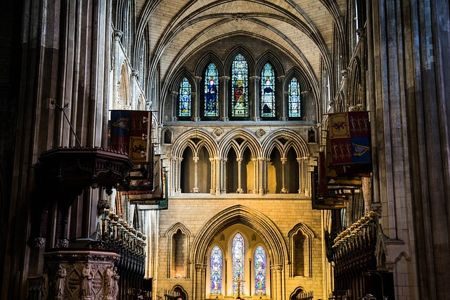
Christ Church is 10 minutes away and has a puzzling medieval crypt that’s 13th century in origin and envelopes the entire length of the building. Incidentally, this is built on the site of Dublin’s first church that was constructed out of timber in the year 1028. Look out for the 14th-century ornate tomb of the conqueror Strongbow and the pretty heart-shaped shrine hosting the embalmed heart of St Laurence O Toole.
It’s a sacrilege not to visit Trinity College when you are in Dublin. The campus dates back to 1592 and has alumni like Oscar Wilde, Johnathan Swift and Bram Stroker. The original design of narrow cobbled paths, gardens and enclosed parks has been carefully preserved and most of the buildings date back to the 18th and 19th centuries.
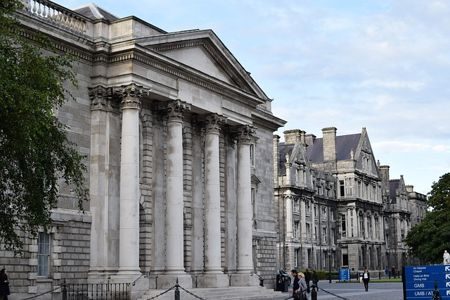
Explore the Douglas Hyde Gallery that hosts fantastic exhibitions and the gallery of modern Science. However, the jewel in the Trinity crown is literally inside its treasury that has the iconic long room library….one of Europe’s best stocking 2000,000 and more of the rarest books. And a look at the Book of Kells with its mythic backstory, the old Irish harp exhibit and Durrow and Armagh books are worth waiting for…take the guided tour so that you can understand the place better.
Dublin’s erstwhile reigning castle has its first stone laid down by England’s King John in 1230 and its splendid history involved its function as a fortress, execution spot, dungeon and court. You can imagine the architectural changes at every stage though right now it’s a tottering campus than an identifiable castle, but it holds the regal state apartments and a number of museums including the famous Chester Beatty gallery and library.
This library and gallery has important oriental art, French books dated the 14th century, artefacts and prayer books belonging to Spain’s Philip II, Islamic scripts and Sanskrit manuscripts apart from Buddhist sacred paintings, miniatures from turkey and Persia, Egyptian papyrus and clay tablets from Babylon. Simply put, the range of exhibits will blow your mind even if you are not particularly a history lover.
All important events of Dublin take place here…if you aren’t in time for one then at least explore the undercroft, chapel and state apartments (a guided tour is recommended). Dublin is a city that has seen a lot of historical turmoil and you may have a déjà vu moment when you visit the Kilmainham Gaol; Europe’s biggest unoccupied prison. It looks haunted by its famous inmates….Charles Stewart, the president Eamon de Valera and Robert Emmet and some young leaders of 1916 rising (they were executed). The tour here will sensitise you to Irish history and the horrific conditions of that era.
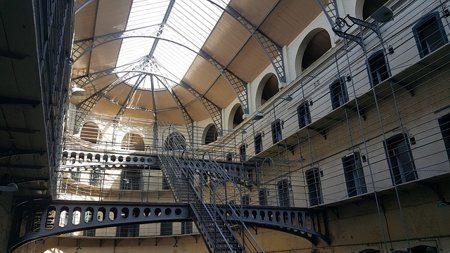
There are lots of free museums in Dublin and they have incredible stories to tell. The Palladian-style building hosting the National Museum of Ireland is fantastic in itself and some of the stashes inside are embalmed bodies of people from the Iron Age and a 45,000-year-old logboat from Galway County. Then there is the National Gallery of Ireland with its sensational fine art collection including work done by Jack B Yeats (Yeats museum, Baroque room, Room of Shaws and separate series of rooms dedicated to Italian painters).
There is the National Museum of Decorative Art and History that sums up Irish designs and the couture evolution and the interesting Francis Bacon studio in Hugh Lane Gallery. The Little Museum of Dublin (this isn’t free entry) showcases the personal history of Dublin through delightful memorabilia, pictures and letters along with the artwork. Watch the U2 Made in Dublin permanent exhibition here which narrates the story of the city’s iconic rock band. John F Kennedy used lectern when he spoke to both the houses of the Irish parliament in 1963 is also kept here.
Continue your walk from The Little Museum of Dublin past the historic Shelburne hotel and then you will reach the seat of the Irish Parliament on Kildare Street. The parliament building looks like an opulent Georgian mansion thanks to the efforts of James Fitzgerald (the Earl of Kildare) who commissioned it in 1745. He later became a duke and named the place Leinster House…either way the building is fascinating.
Just opposite the road, you can see a branch of the National Museum of Ireland…this branch has the historic Ardagh chalice, the collection of Viking artefacts and prehistoric Ireland. A short walk further will take you to the National Library where you can browse through W.B. Yeats collection of original work.
Once your afternoon is spent you can wolf down some hearty Irish smoked fish in the basement eatery.
The city loves and cherishes its green spaces and the Phoenix Park with its graceful herds of fallow deer is the proof (Europe’s biggest enclosed park in a city). Tour the Irish residents’ official residence and a lovely historic property that’s home to the American ambassador to Ireland. There is a visitor’s centre here that will let you know all about Ashtown Castle tower house, Farmleigh house and the second oldest zoo in Europe….the Dublin Zoo.
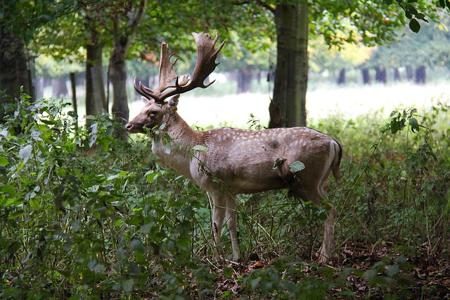
Touring this place will justifiably take half a day and if you are with kids then maybe longer. Be prepared for loads of fun at the Reptile house, sea lion section, orang-utan enclosure and penguin centre. Restaurant, kid’s zone and family farm are some of the facilities provided here.
There is a utopia like Iveagh Gardens that’s perfect for picnics and restful breaks and the pretty with a morbid history St Stephens Green which used to host exhibitions in the 17th century. Look around the Green (its nickname) and you can spot a bevy of Georgian buildings and look inside and you will find a restful haven of kids playground, fountain and a duck pond.
Also, watch out for the Merrion Square once you go out of the main portal of the national gallery ….Dublin’s magnificent city square with the Oscar Wilde statue is an ode to history. Check out the buildings nearby…the buildings have top windows smaller than the lower ones and they look taller than they actually are. Come here during the weekend and you will see local artists showing off their work.
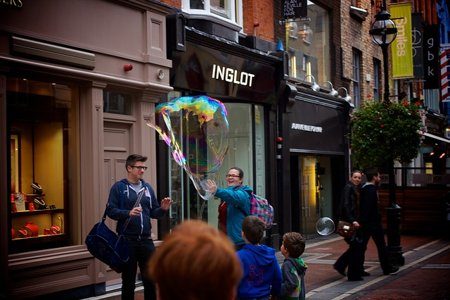
Dublin’s biggest thoroughfare is O’Connell Street that has the impressive-looking 1814 dated GPO that contains ‘a post museum’ with permanent lives, letters and liberty exhibition. Learn all you want about the 1916 uprising and the struggle to independence here…if you wish you can also read the Proclamation of Independence. A ten-minute walk from the GPO will take you to the James Joyce Centre that has the largest collection of artefacts and framed work of the celebrated author…this is created by the Irish senator and Joyce fan David Norris.
On a different note, the Jameson Distillery guided tour (on Bow Street) is a must for anyone who loves Irish whiskey. A 40-minute tasting tour and a retelling of the innovations created by Jameson as well as an explanation of the distillation process is provided….right from milling to mashing to maturation and the legendary “angels share”. There is also a gift shop here….buying personalised Jameson’s bottles are recommended.
If you are taking just one day trip from Dublin then it should be a 20-minute train ride in the southern direction to Dalkey Town. Go up to the historic Dalkey castle that stood over the major trading centre on the east coast of Dublin. There is a visitor centre here that disseminates information about the area, holds exhibitions and even hosts live theatre as part of an immensely interactive guided tour.
Explore the Coliemore road harbour and opposite to it is the lovely Dalkey Island. Go uphill for about 12 minutes and you can reach the Vico road that commands a fine view of Killiney Bay. You can also go up to Killiney Hill that has a fantastic park teeming with exotic fauna and avian species. Incidentally, the DART train will easily take you to both Dalkey and Killiney.
A great way of experiencing Dublin from a whole new perspective is to take the Dublin Bay Cruises and sail on the lovely Dublin bay. The MV St Bridget boat has a capacity of 120 passengers and there are several scheduled cruises every day that connect the picturesque seaside towns such as Dun Laoghaire, Howth and Dalkey Island to Dublin City Centre. You can take a beer, wine or coffee and enjoy the sail that offers a lovely view of the coastline.
The 5 pm round trip cruise from Dun Laoghaire via Joyce Tower, Forty Foot, Dalkey Island, Killiney Bay and back at 6.15 pm is a special experience. You can know more about the boat trips and book the cruise through this Dublin Bay Cruise Website.
Food and Drinks
Dublin has an interesting mix of Michelin starrers and traditional Irish restaurants and chef-owned places that serve world food with a twist.
The unassumingly named L Mulligan Grocer was once just a pub but now is a full-fledged restaurant that presents its menus tucked inside children’s books. All the meat served here is grass-fed, the cheese made in the farmhouse and the beer …craft. Located at Stoneybatter this place serves Dublin’s finest Irish fare with a twist and gives away free candy pouches with the bill.
Oxmantown in Mary’s Abbey is where you go to dine like a Viking though the menu is dominated by sandwiches. The humble dish is executed in perfection and you only have to bite at the black pudding enriched butcher sandwich to know its genius.
Speaking of sandwiches the Pepper Pot Café on S William Street has fantastic pear and bacon along with great bagels and delicious scone-jam and cream. Fumbally is now the best breakfast place in Dublin and scrambled eggs with cork cheese, garlic, tomatoes and basil are the best.
Richmond Place South… a vegan eatery (more like a food truck) that serves different themed vegan food every week. There’s an Australian chef here who has captivated the herbivores. The pretty park converted from Dublin’s Grand Canal holds Locks that serves lovely seasonal food. Come here for lunch and taste violet artichokes with fennel, beans and burrata.
Rosa Madre on Crow street is relatively less touristy and is one of the best places to taste local seafood-based dishes. Try the scallops with parmesan or the Dublin prawns with claws.
If Michelin stars are what you seek then Chapter One on Parnell Square will not disappoint. Perfect for special occasions, Chef Ross Lewis sources locally and conjures up culinary marvels. Try the wild turbot with langoustine dumpling and white asparagus or the sika venison with baked parsnip….tables have to be booked many weeks in advance.
Another Michelin starrer is The Greenhouse on Dawson street that’s presided by Finnish chef Mickael Viljanen whose food is visually stunning and Nordic in origin. Celeriac in the skin of rye is dressed to look like aubergines and broccoli and baby onions are used to create fantastic plate décor….keep your camera handy!!
Mr Fox on Parnell Square has gutsy dishes created by popular chef Anthony Smith. Taste the venison with artichoke crisps and red currants or the deer tartare and finish off with the walnut whip Nescafe. If native Irish fare interests you and ambience isn’t a compulsion, the Klaw on Crown alley is the most fantastic place to try Irish oysters at their creamiest best along with langoustines and lobster. The place is tiny and often fully packed.
The family-run Da Mimmo on north strand road serves hearty Italian fare along with pizzas. Order risotto with sausage and clam decked spaghetti and find it all drowned in parmesan and butter. Terra Madre on Bachelors Walk is also an Italian affair. Gaillot et Gray on Clanbrassil Street arguably serves Dublin’s best pizza though it’s French and not Italian in origin so expect Emmental cheese and not mozzarella. Bring away a few loaves of their freshly baked sourdough bread.
Go down the rustic stone steps and warm your cockles on Tuscany inspired octopus and chickpea stew, lardo on munchies toast and salami sprinkled with salami. Chameleon on Lower Fownes Street serves Indonesian feasts. The house speciality is house beef with black anise crust….insiders say that it is cooked for 10 hours. Vegetarians will love the Balinese curry that’s filled with coconut, butternut and string beans.
The Ramen Bar on S William Street stands in the basement of a popular sushi place Kokoro. The noodles, tonkatsu pork and vegetable soup are famous here. Las Tapas de Lola is Spanish and stands on Wexford Street and the ingredients are mostly sourced from Spain. Try the cheek of pork with fiery red sauce and inspect the rich sherry and vermouth lists. Hang Dai on Camden Street has a serious quality Chinese food though it looks like a takeaway joint. Duck with crispy skin is a house speciality and you can even taste duck brain here.
Nightlife
Given how famous Guinness is, it’s understandable that the focus of the nightlife in Dublin is on drinking like a fish. That said, these are the most interesting places to do so.
Long Hall on Great George’s street is an antique shrine to drinking and has Victorian interiors that date back to 1880. It closes right around midnight though. The Sugar Club on Lower Leeson Street has an amazing banquette where the top Irish artists come to perform. Come here to get entertained and sample the excellent bar menu.
Brazen Head on Lower Bridge Street is officially Dublin’s oldest pub and it has a quaint bar area lit up with lanterns. Live music sessions happen every night and there are even storytelling events. Stag Head on Dame CT has an actual stag’s head displayed over the mahogany bar. This is where you should go to enjoy hearty Irish food, spirits and comedy nights along with an abundance of Guinness.
Cafe En Seine on Dawson street is Parisian, chic and intimate and offers music, fashion and excellent spirits….the place has an 80’s vibe and remains open till 3.00 a.m. Grand Social on Lower Liffey street has interiors inspired from a circus and a happening live music scene….all the best D.J’s of Europe have played here at some point.
Copper Face Jacks is a part of the famous Jackson court Hotel and it has an abundance of bling and blinding lighting. Members get special gold cards and the music is out of the world.
If you want to spend the whole night out then Fitzwilliam Club on Fitzwilliam Street is a classy venue. It’s a nightclub and an amazing casino with exciting poker tournaments.
Temple Bar area is packed with great pubs, bars and a smattering of clubs and is essentially one big nightlife zone. One of the stars here is Temple Bar that houses more than 420 bottles of scotch and bourbon and serves excellent oysters and Guinness. Guinness fans can also visit O Donoghue’s that’s a typical Irish pub with the creamiest black liquid ever. Only local bands perform here and you will get the untainted Dublin flavour.
Alternatively, you can go on a Dinner cruise on the Grand Canal with 3-course gourmet meals and champagne. And if you wish the vessel can be restored vintage boat that was once used to transport Guinness barrels.
Shopping
Shopping in Dublin is atmospheric and can be called a cultural experience rather than just a retail one. Once you have been to Trinity College, can Grafton Street be far behind? It’s arguably Ireland’s best shopping destination and has a fine statue of Molly Malone adorning it. Walk along and you can hear fiddle players and classical quartet players along your shopping journey as a songwriter wandering by to write a song just for you and if you are lucky catch a performance by a travelling band.
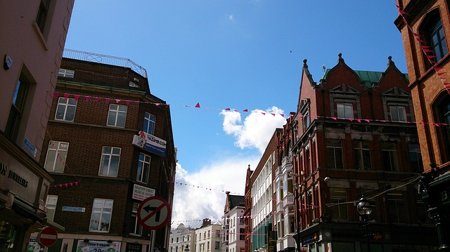
Brown Thomas departmental store is upmarket, chic and demonstrative of contemporary Irish trends.
Wandering on Francis Street is as much sightseeing as a shopping activity. Shop for all things antique here right from chandeliers to oil paintings to vintage jewellery. The O Sullivan Antiques is the brightest store here. The superbly designed Irish design shop displays more than 50 different purely Irish designed products that range right from shawls to lamps…drop in even if you don’t actually buy.
The famous Temple Bar area has the Bob Johnson Gutter bookshop that now has a branch in Dalkey. Shop for Irish writing and pretty stationery.
Dublin has its own creative quarter which is a platform for Irish designers, merchants and locally made items. Industry Co here sells ceramics, throws, pottery, jewellery and homeware while its sister shop Barn 21 sells incredible children’s gifts and toys.
Suffolk Street has the flagship Avoca store though there are many branches at several places. You will find lovely home furnishings, blankets and throws and designer clothing here. Also look out for the organic candles and diffusers here and sample the gorgeous baked goods in the café downstairs.
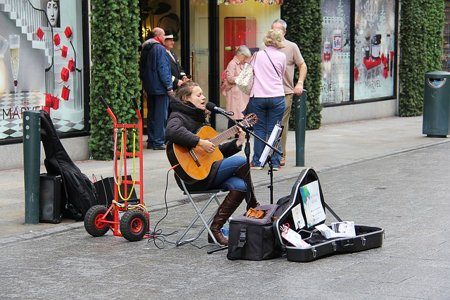
If you want to buy authentic Irish crystal then Kilkenny on Nassau Street is a huge design emporium that bursts with exquisite glass items…you will get Waterford crystal, Orla Kiely mugs, pottery by Stephen Pearse and so many other collectible items.
South Great George Street has lovely red Georgian buildings and a lovely Arcade that has many delightful standalone stores. Shop for fresh cinnamon buns at Simons and pick up bunches of cut flowers at Appassionato ….you can get a range of stuff here like second-hand clothes, books, organic food, dance accessories.
The Green Door Market has a colourful ambience and is the best place to shop for organic food like cheese, wine, deli and paleo items and fresh fruit and vegetables. Once in a month, the sought after Broante Flea Market arrives here. For a more upscale food shopping experience the Dollard & Co in temple bar is perfect; everything from Irish cheese to red quinoa is on offer.
How to reach
Dublin airport is one of Europe’s busiest airports and most cities in continental Europe and UK apart from North America and Dubai-Abu Dhabi have direct flights to it. The airport has 2 terminals and is 10 km away from the city close to the M50 and the M1 motorways.
The best way to get to the city from the airport is to take a bus….Airlink, Air coach and Dublin Bus have good services.
Dublin Port is just about 2 miles from the city centre and Irish Ferries is the major operator here. Frequent connections are available to Holyhead, Liverpool and Isle of Man apart from other nearby ports. The Dun Laoghaire Port is 30 minutes from the city centre and you have a choice of disembarking here as well.
From the port, you can take a bus (#53) to the bus station or the city centre.
Getting around
Dublin Bus runs bus services for the Dublin County and the network is extensive. You should get a map first from the head office on O Connell Street. Try catching a double-decker one…the experience is fun.
Bus Eireann runs to places more remote than those covered by Dublin Bus and its special use involves exploring the lovely Irish countryside.
The DART (Dublin Area Rapid Transit) train service runs along the Dublin coast and connects Howth and Malahide (north) to Greystone (south). For anyplace outside this zone use the Suburban Rail network (a by-product of the historical Irish rail) and go off on country side tours.
LUAS trams also run in the city though they don’t connect all parts of it. Taxis are found in abundance in and around the city
There is the Dublin Pass which entitles you to a hop on hop off tourist bus tour of the city with free entry to 30 attractions. The Dublin freedom pass is another variant where you get unlimited transport and hop on hop off tours. There are early access passes to in-demand activities like Guinness storehouse, Book of Kells etc. that will allow you to skip lines.
Read: Local transports in Dublin and how to get around.
When to Visit
June to August is the most popular slot to visit…the air is warm and lots of festivals happen. But hotels are all mostly filled up and flight prices soar up.
For a balance between economy and enjoyment visit in the Spring and Fall i.e. March to May and September to November. Between the two slots, fall is preferable as art and theatre festivals start happening around this time. However there is sure to be a nip in the air.
Winters are when hotel prices are at the lowest and you can see attractions undisturbed by crowds but then you will have to fill yourself with Irish whiskey to prevent your teeth from chattering.
Read: Important weather conditions in Ireland including Dublin
 A travel addict. Still celebrating the day when he quit his high-profile corporate job to pursue his passion for travel writing.
A travel addict. Still celebrating the day when he quit his high-profile corporate job to pursue his passion for travel writing.